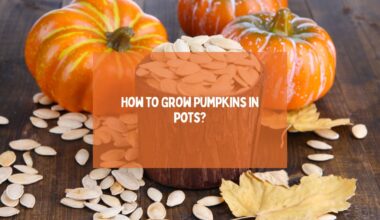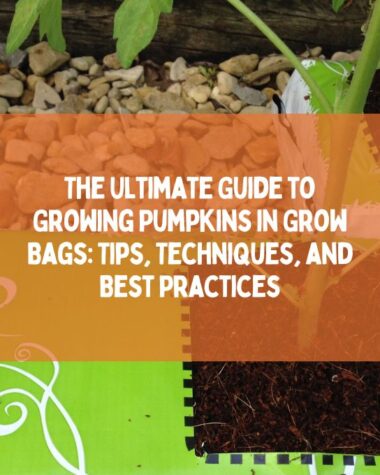Growing pumpkin patches requires a series of steps to be carefully followed, starting from selecting the right location and preparing the soil to planting the right variety of seeds and providing the necessary care for the plants to grow healthy and strong. Proper watering, fertilization, and pest management are crucial aspects of pumpkin patch maintenance.
Growing a pumpkin patch can be a fun and rewarding experience that can yield beautiful and delicious pumpkins. It requires careful planning and attention to detail, but with the right approach, anyone can successfully grow a thriving pumpkin patch.
In this article, I will tell you how to start growing pumpkin patches.
Let’s start.
7 Steps To Grow Pumpkin Patches
Starting a pumpkin patch can be a rewarding and profitable venture. Making the patch look and feel welcoming and advertising it well can help bring in customers and make money. With attention to detail and a willingness to put in the work, anyone can successfully grow a pumpkin patch.
It’s important to avoid areas that are prone to flooding, as waterlogged soil can cause root rot and other problems. By selecting the right location, you can provide your pumpkin plants with the ideal growing conditions and increase your chances of a successful harvest.
1. Prepare The Soil
Preparing the soil is an essential step to growing pumpkin patches successfully. Pumpkins prefer well-drained soil with a pH level between 6.0 and 7.0. Before planting, you should remove any weeds, rocks, or debris from the area and loosen the soil to a depth of at least 12 inches.
Pumpkins require a lot of nutrients to grow properly, and the soil in your patch may not have all the nutrients your plants need.
It’s crucial to avoid planting in compacted soil, as this can restrict root growth and reduce yield. By properly preparing the soil, you can create an optimal environment for your pumpkin plants to thrive.
Related Reading
2. Select The Right Variety
Selecting the right pumpkin variety is crucial for a successful pumpkin patch. There are many different varieties of pumpkins to choose from, each with its own unique characteristics. Some pumpkins are better suited for cooking, while others are ideal for carving.
When selecting a variety, consider the climate in your area, the size of the pumpkin you want to grow, and the intended use of the pumpkin. For example, if you live in a warmer climate, you may want to choose a variety that is more heat-tolerant.
If you want to grow pumpkins for carving, look for a variety that has a thick stem and a flat bottom, making it easier to carve. Additionally, consider the space you have available for your pumpkin patch and choose a variety that will fit in that space.
3. Plant The Seeds
Growing pumpkin patches can be a fun and rewarding experience, whether you’re a hobbyist or a commercial grower. Pumpkins are a versatile crop that can be used for decoration, cooking, and even carving for Halloween.
Growing pumpkins requires a bit of planning and attention to detail. Now you have to plant the seeds of the selected variety in the soil you have prepared.
4. Provide Adequate Water
Providing adequate water is essential for growing healthy pumpkin plants. Pumpkins need consistent moisture throughout their growing season, especially during hot and dry weather.
It’s important to water your pumpkin plants deeply and regularly, ensuring that the soil is moist but not waterlogged. Overwatering can lead to root rot and other diseases, while underwatering can cause stunted growth and smaller pumpkins.
Think about using a drip irrigation system or a soaker hose to get water right to the roots and reduce the amount of water that evaporates. By putting mulch around your pumpkin plants, you can keep moisture in and stop weeds from growing, which makes it easier for your plants to get water and nutrients.
5. Fertilize Regularly
Fertilizing your pumpkin plants regularly is an important step in growing a successful pumpkin patch.
It’s important to supplement the soil with fertilizer throughout the growing season. The best way to fertilize your pumpkin patch is to start by testing the soil to determine what nutrients it may be lacking.
You can choose a fertilizer with the right nutrients and use it according to the directions on the package. It’s important to avoid over-fertilizing, which can burn the roots of your plants, so be sure to follow the instructions carefully.
6. Manage Pests And Diseases
Managing pests and diseases is an essential step in growing a successful pumpkin patch. One of the most important things you can do is to choose disease-resistant varieties of pumpkins, as this will minimize the risk of pumpkin plant diseases.
It’s also important to keep the pumpkin patch free of weeds and debris, which can harbor pests and diseases. Rotating crops each year can help prevent the buildup of soil-borne diseases and pests.
If you check the plants often for signs of pests or diseases and act quickly if you find any, like removing the affected plants or using natural pesticides, you can help stop the problem from spreading.
7. Harvest The Pumpkins
To harvest, cut the stem of the pumpkin with a sharp knife or pruners, leaving a few inches of stem attached. Be careful not to damage the pumpkin or the stem, as this can lead to rot or other issues.
After harvesting, allow the pumpkins to cure in a warm, dry place for a week or two to toughen up the skin and improve their storage life. Once cured, you can store your pumpkins in a cool, dry place for several months or use them for cooking, decoration, or carving.
Related Reading
Understand Cucumber Pollination Process: How Cucumbers Pollination Works?
Understanding Deformed Carrots And How To Fix Them
10 Reasons Your Tomato Plant Leaves Are Turning Brown
Conclusion
Choosing a suitable location is a crucial step in growing a successful pumpkin patch. The location should also have well-drained soil that is rich in organic matter, as pumpkins prefer soil that is loose, fertile, and well-aerated.
Pumpkins require a lot of sun and space, so it’s essential to choose an area that receives at least 6 hours of direct sunlight per day.
By following the steps above, you can enjoy the results of your hard work and maybe even make money by selling pumpkins or holding seasonal events.
Thanks for reading!







